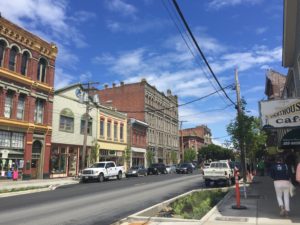Links to the entire set of notes
Page numbers refer to the page in the PDF and print versions.
95—he was in a gang. Alby’s childhood neighborhoods were infamous for their gangs as early as the 1820s, when an Irish gang called the Forty Thieves was active in Five Points. There are some good photos here and lots more good stuff here. I didn’t specify in the story, but Charley was most likely a member of the Whyos.
96—He’s in a town called Port Townsend. The town of Port Townsend was founded in the Pacific Northwest in 1852. It lies at the northeast tip of the Olympic Peninsula, right atop Puget Sound. At one point, people predicted it would be the West Coast’s largest port. That didn’t happen due to a depression and unfavorable railroad lines, but it remained a viable town. Today it’s a wonderful place to visit, but during its heyday it was a fairly rough-and-tumble place. It’s still home to a major ship repair yard.
96—My sister, Aspasia. Aspasia was an influential woman in Athens during the 5th century BC.
103—There’s increasing demand for goods from Asia. Japan opened to trade with the West in 1868, and Japanese imports became very popular in the U.S. Chinese exports such as porcelain were also in demand here. In London, fondness for blue-and-white porcelain amounted to Chinamania in the 1870s. Goods coming to the US from Asia landed at West Coast ports such as Port Townsend.
104—Port Angeles. This is another town on the Olympic Peninsula, about 45 miles west of Port Townsend. It was just beginning its growth during Alby’s time. Logging was a major industry, and the town is also conveniently located directly south of Victoria, Canada, across the Strait of Juan De Fuca.
 106—this was the Olympic Peninsula. The Olympic Peninsula lies across Puget Sound from Seattle; if Washington were a mitten, the OP would be the thumb. The Olympic Mountains run down the center of the peninsula, and the peninsula rain forests get over 12 feet of rain a year. Port Angeles is considerably drier than that, however, with only about 2 feet of rainfall yearly. But a lot of that rain comes in a light drizzly mist, and it rains an average of 230 days per year.
106—this was the Olympic Peninsula. The Olympic Peninsula lies across Puget Sound from Seattle; if Washington were a mitten, the OP would be the thumb. The Olympic Mountains run down the center of the peninsula, and the peninsula rain forests get over 12 feet of rain a year. Port Angeles is considerably drier than that, however, with only about 2 feet of rainfall yearly. But a lot of that rain comes in a light drizzly mist, and it rains an average of 230 days per year.
107—Did I tell you Father sent a telegram yesterday? Commercial telegraphy was available by the mid 19th century. In 1890, Marconi was still a few years away from perfecting wireless communication, but a transcontinental telegraph wire had been in place since 1861. By Alby’s time, Western Union was the major player, and it would have been fairly simple and relatively inexpensive for someone to send a message from New York to Washington State. Western Union handled over 55 million messages in 1890.
I hope you’ve enjoyed these notes! I’d truly appreciate your feedback so I can assess whether to publish notes for future stories!
